- Job Description Process Improvement: How One Workflow Fix Saved 1,200 JDs from Chaos - December 4, 2025
- Affordable Job Description Management Software (That Still Do the Job Right) - November 19, 2025
- AI is Flooding Your Jobs With Unqualified Applicants (We’re Still Figuring Out How to Fix It) - November 18, 2025
Racial bias can be present (knowingly or unknowingly) in every aspect of the hiring process.
We found 10 tools for eliminating racial bias from job descriptions to resume screening to interviewing.
1. Ongig’s Job Description Text Analyzer
Racial bias is often present in job descriptions and there are text analyzer tools that can help remove it. Ongig’s Text Analyzer quickly scans and identifies “exclusionary phrases” based on the reader’s:
- Ethnicity
- Primary/secondary language
- Immigration status
Below is an example of a job posting that includes hidden bias with the popular phrase “brown bag sessions”. This phrase has been used for years but some find its linked to racism and colorism (people used to measure the darkness of someone’s skin by holding a brown paper bag up against their face…if the skin was darker than the paper bag, the person might get rejected by certain social groups).
The screenshot below shows how Text Analyzer underlines “brown bag” and gives alternate words like “lunch and learn” or “learning session” which are more inclusive, especially when recruiting minorities.
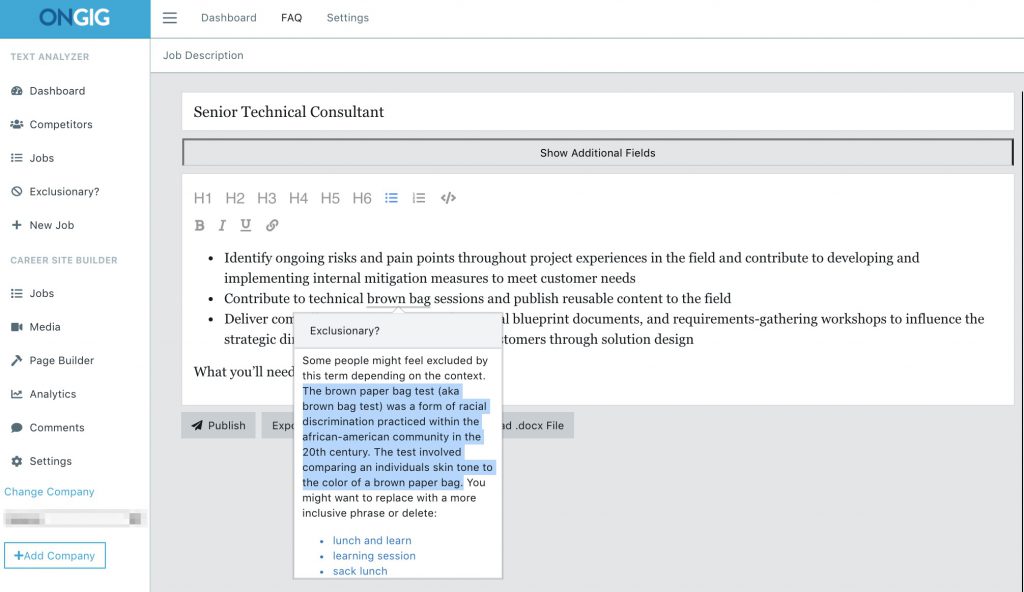
When recruiting groups of candidates such as BIPOC (Black, Indigenous, People of Color) or recruiting BAME (Black, Asian, and Minority Ethnic), it is critical to remove racially biased words (or hidden bias) from your job descriptions.
Another example of an exclusionary word related to ethnic diversity is “native English speaker” (below):
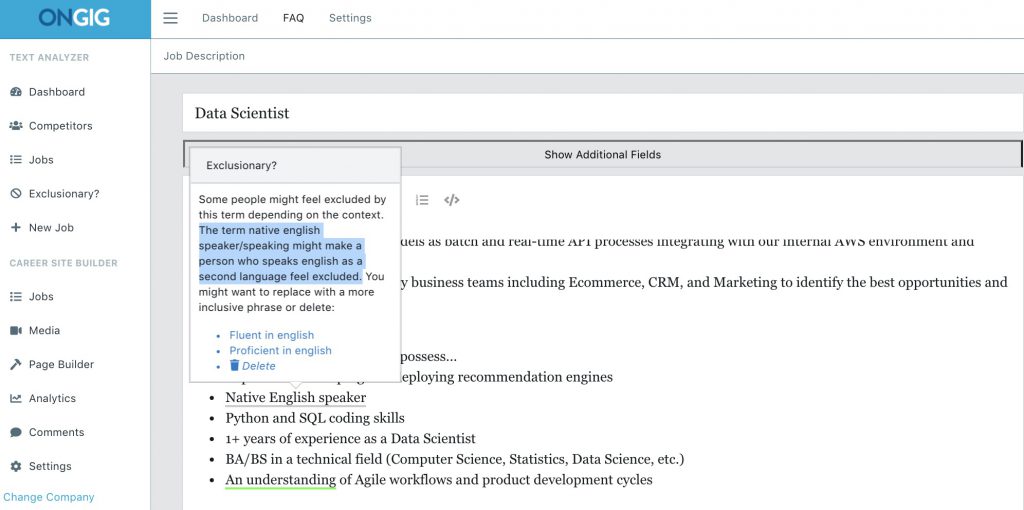
After all, you want to hire someone who speaks English fluently more than you want to hire a person born in the U.S., right? If your goal is recruiting different ethnic groups or ESL recruiting, removing this type of racial bias is important.
Ongig’s Text Analyzer also helps you with types of hidden bias other than racial bias such as:
- gender bias
- ethnic bias (multicultural bias)
- disability bias
- LGBTQ (sexual preference)
- neurodiversity
- age bias
Blind Hiring Tools
How can employers avoid racial discrimination when recruiting and hiring? Many companies are incorporating racial bias tools as a part of their recruiting culture. Blind hiring tools like GapJumpers and Toggl Hire help remove bias from the hiring process.
2. GapJumpers
A popular blind hiring tool to help remove hidden bias is called GapJumpers helps employers create an assessment or “challenge” that relates to the skills needed for an open position. This tool helps remove any chance of racial bias because candidates are ranked based on their performance, not on identifying factors (e.g. their name, education, volunteer work, etc.)
Hiring managers can choose who to interview based only on the performance and scorecard of the potential candidates. The GapJumpers plug-in can also be synced with an Applicant Tracking System (ATS).
The picture below shows an example of what an assessment would look like from the candidate side. It also gives more detail on how to create a GapJumpers blind hiring challenge.
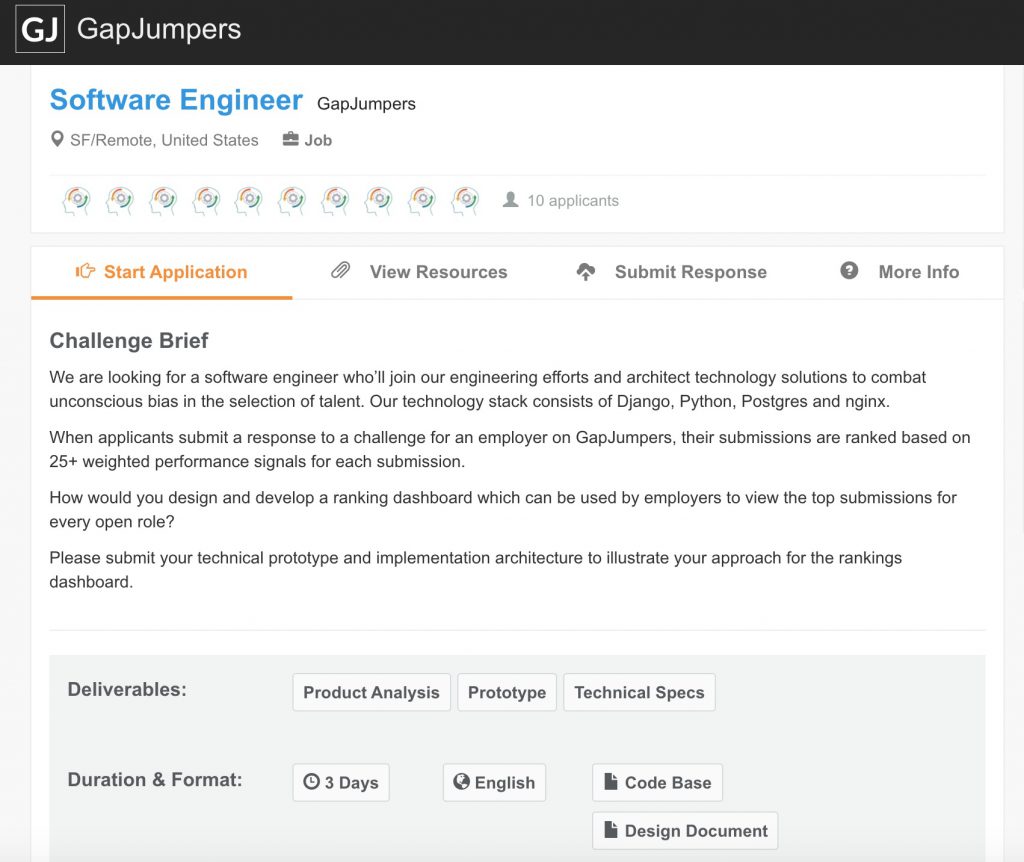
3. Toggl Hire
Similarly, Toggl Hire allows candidates to apply for a job by taking a quick 5-10 minutes skills-based quiz. These quizzes help hiring managers to not only hire by race. Toggl Hire’s blind skills-based candidate screening software:
“checks all the answers, and provides you a list of the most potential candidates, without ever looking at their subjective factors such as age, gender, education, previous work experience etc.”
The skills-based quizzes are customizable like the one pictured here:
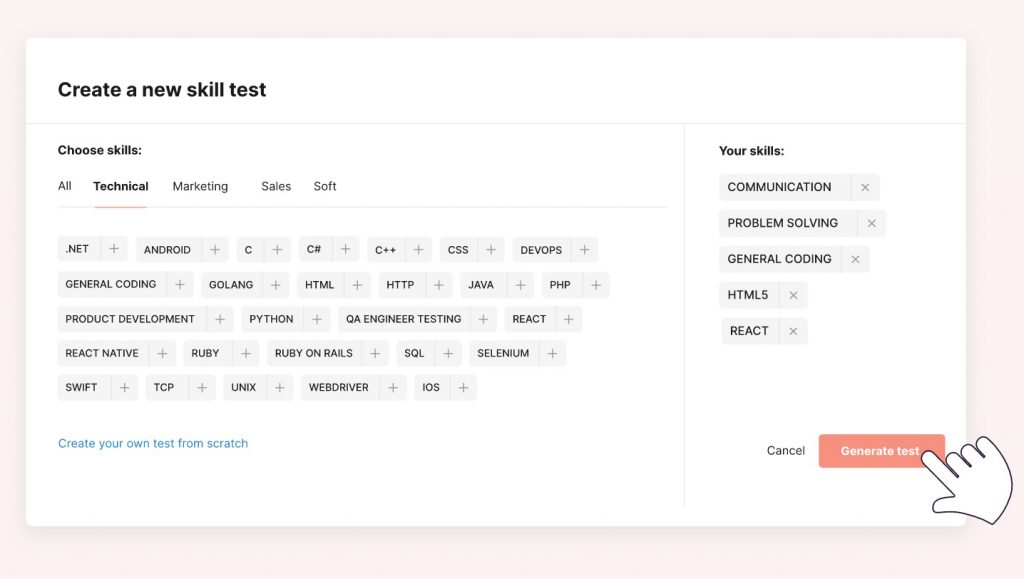
Using skills-based quizzes can remove hidden bias from your hiring and interviewing processes.
4. Greenhouse’s Built-In Inclusion Module
Greenhouse Software has built-in inclusion and diversity tools in their Applicant Tracking Software product. Inclusion tools like this help hiring managers set decision criteria so that all candidates are being held to the same standard. In the tool, built-in popups (e.g. below) remind the hiring team to have an open mind during the hiring process:
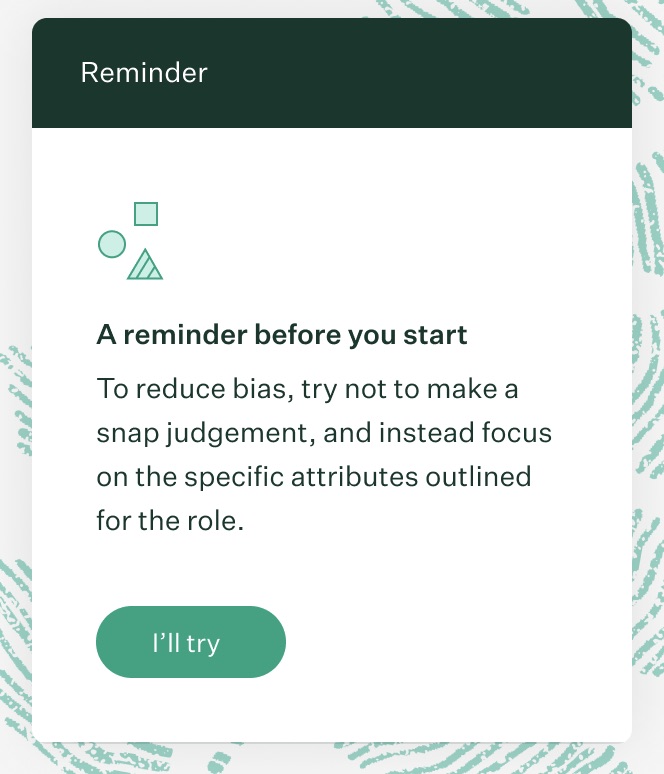
We’re hearing that some Greenhouse clients value the Inclusion module’s ability to help them measure:
- % of applications from [name of underrepresented group]
- % of candidates who reach interview stage from [name of underrepresented group]
- % of candidates hired from [name of underrepresented group]
Software tools for racial bias, like this inclusion module, have gained popularity in the last few years. Racial diversity and recruiting multicultural leadership have also become popular diversity goals for top companies. These diversity hiring tools help eliminate hidden bias.
5. Harvard’s “Project Implicit” Tool
Diversity training is extremely important, especially for employees taking part in hiring. Harvard University’s Implicit Association Tests (IATs) are used to identify levels of implicit bias. This can help remove racial biased recruiting and hiring practices. Project Implicit focuses on racial bias and a variety of other biases found in a multicultural workplace:
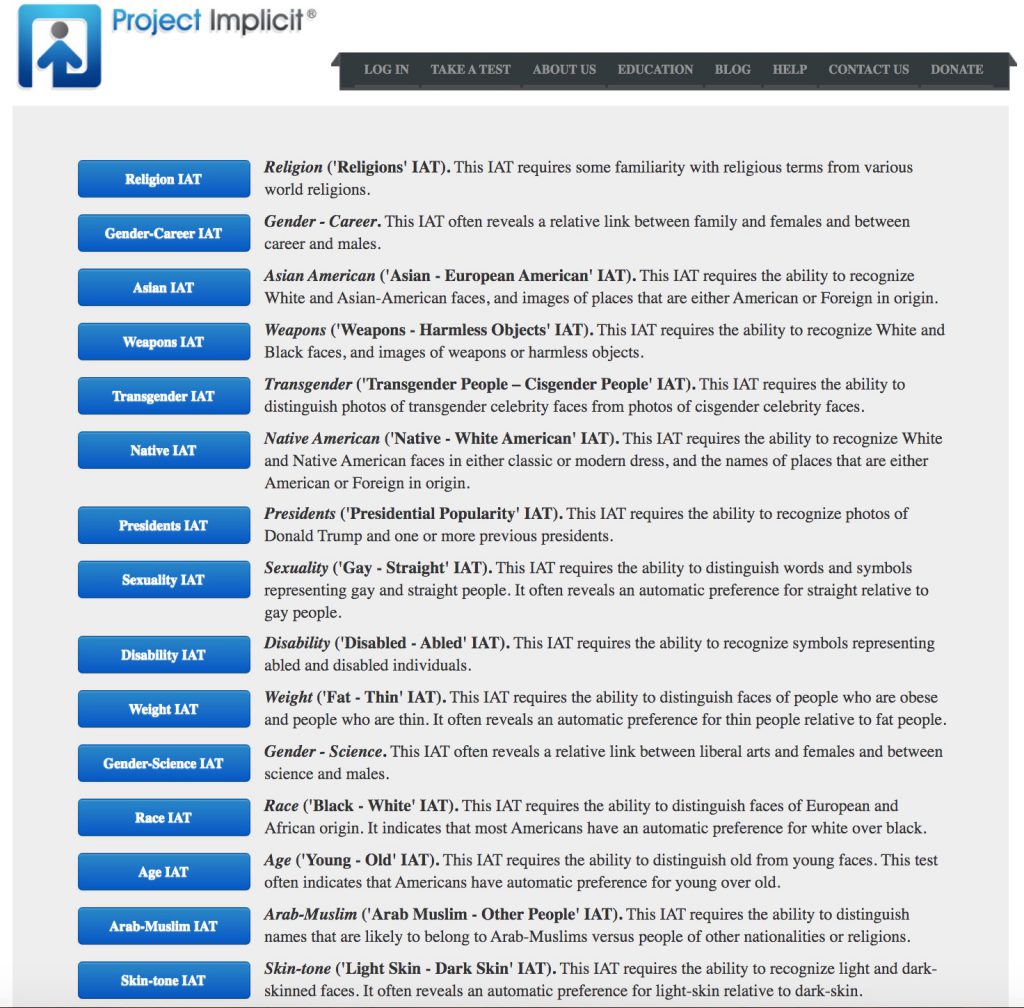
Using cultural diversity tools like Project Implicit can help identify and address potential racial bias in current employees so that it doesn’t spill over to the hiring process. These IATs could be a useful piece of a diversity training initiative.
6. Blind Resume Tools
Blind resume tools are successful urban recruiting solutions because they remove certain details from a resume that could cause racial bias. For instance:
- Name — a candidate’s name can reveal their race
- Address — a candidate’s address could be linked to a certain race or income bracket
- Volunteer work — where someone volunteers can be related to their race
- Name of college — where a candidate went to college could identify their race (e.g. attending a Historically Black College or University)
Clovers’ job description optimizer is one example of “blind resume software” you might use to review resumés based on skills and experience instead of details related to gender, age, race, ethnicity, or socioeconomic status.
You’ll notice in the image below how the blind resume software blocks out these details:
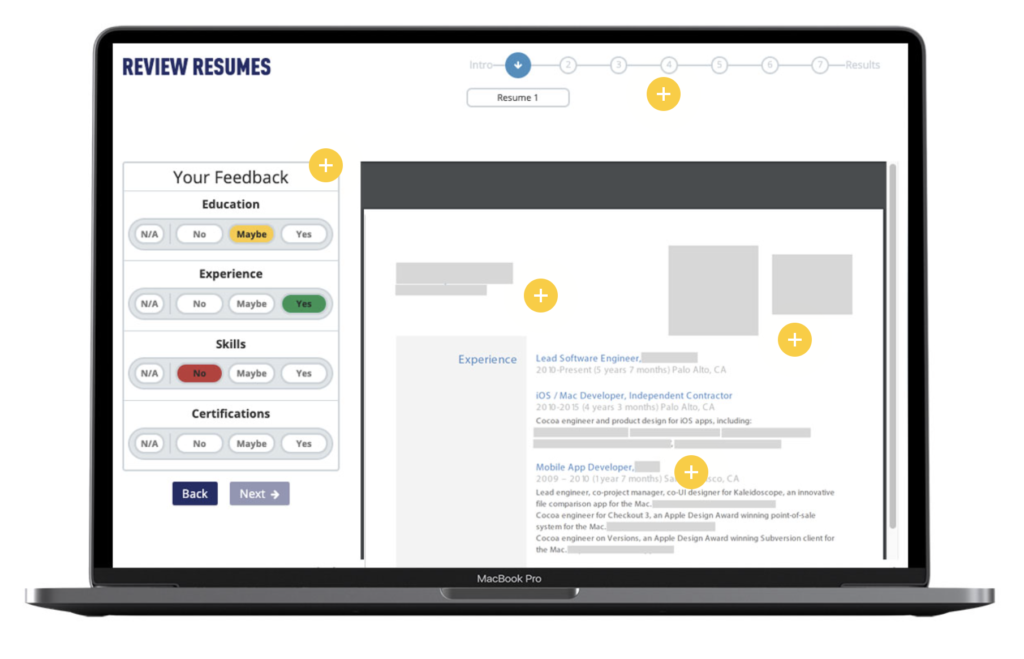
7. Pinpoint Recruitment
Pinpoint Recruitment’s Blind Resume Tool also helps hiring managers solve their racial bias issues by removing items (like the ones above) from candidate resumes. The Pinpoint tool reads applicant data, then presents a redacted resume to the hiring manager using anonymous personal info. The screenshot below shows “Pink Peas” as an applicant and their personal data is hidden for the candidate screening process.
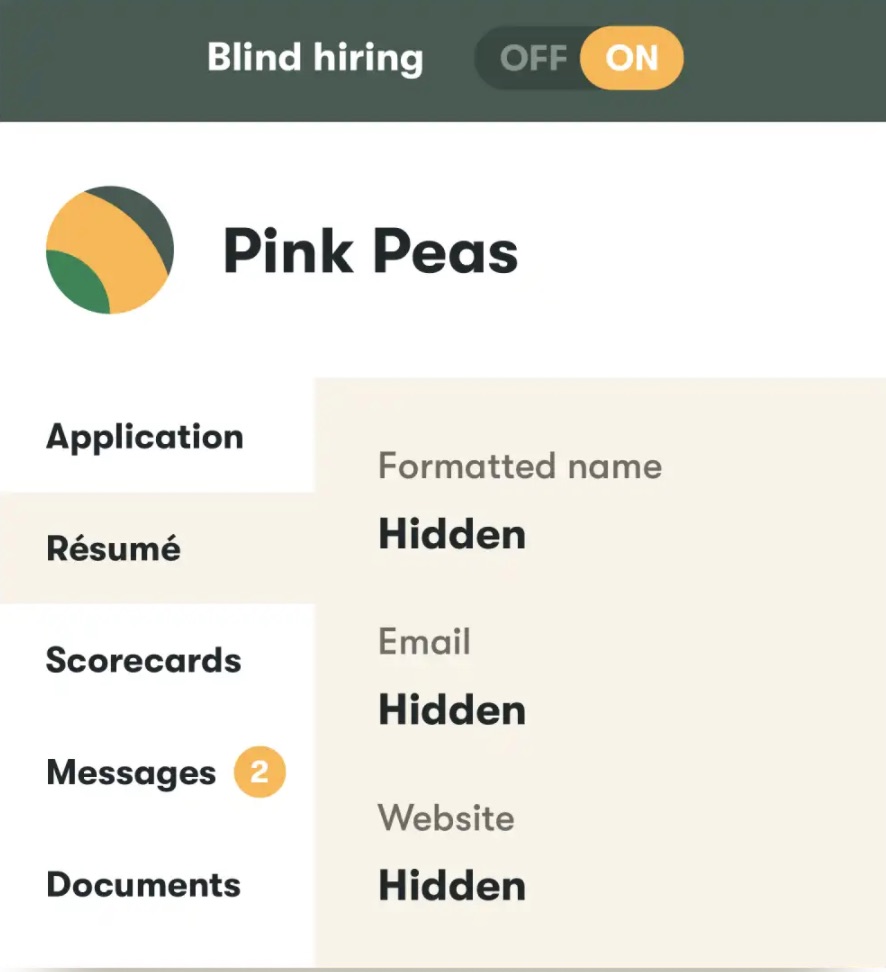
8. Blendoor
Blendoor’s diversity recruiting tool also hides things like name, age, employment history, criminal background, and photos from resumes. This helps employers focus on the relevant and important data related to job qualifications. Blendoor also helps with sourcing by broadening the search for talented and qualified candidates, racial bias aside.
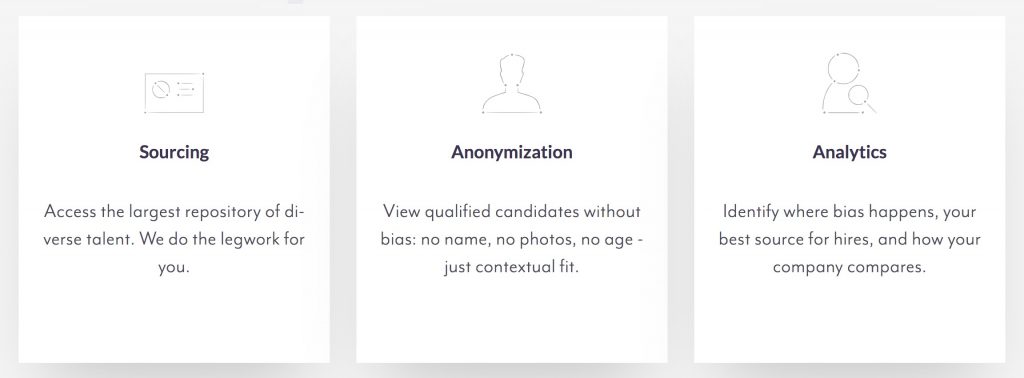
9. Entelo Diversity
Entelo’s unbiased sourcing tool helps employers find a diverse pool of candidates by anonymizing candidate information related to different forms of bias. Entelo also uses an algorithm to help remove racial bias and find candidates from underrepresented groups by scanning their social platforms and other online data. This helps companies create a more multicultural workplace.
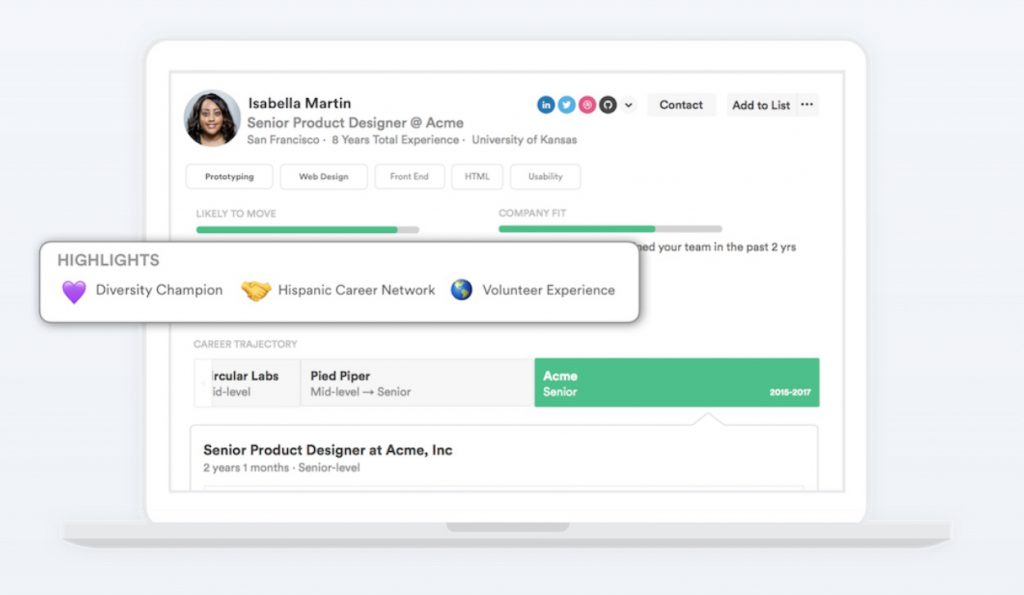
10. AI Chat Bots Remove Bias
Using AI chatbots in the interview process can help promote diversity and remove racial bias. AI chatbots automate the hiring process by taking over the role of candidate screening, interview scheduling, employee onboarding, and answering FAQs. AI chatbots are also blind to color, which helps remove hidden bias and racial bias when recruiting people of color.
John Duarte, founder & CEO of GoHire, said 2019 was the year the chatbot really took off. It’ll be interesting to see if chatbots continue their upward trend and become a POC recruiting technique.
Some top chatbots include:
- AllyO
- Brazen
- Eightfold
- Espressive
- Xor
- GoHire
- Ideal
- Leoforce
- Mya
- Olivia
- Smashfly
- Talkpush
- Wade & Wendy
A couple of good resources on chatbots include Today’s chatbots are becoming more diverse – and so, too, are their creators, Let’s Talk About Race: Identity, Chatbots, and AI (which notes that Chatbot creators have to be careful not to be biased in their programming).
11. DBSquared
DBSquared is all about making workplaces fairer and more equal. Let’s take a closer look:
First off, DBSquared has tools that help companies even the playing field when it comes to hiring and pay. One of their tools, DBDescriptions, helps companies write job ads that are fair and don’t show bias. It also makes sure these ads follow important rules like the ADA and FLSA.
DBSquared also has a tool called DBCompensation. This helps HR folks find any differences in pay within their company. By looking at things like experience, race, and gender, DBCompensation makes charts that show any gaps. For example, it might find that a Latino supervisor is making a lot less money than a white supervisor with the same experience.
Now, let’s talk about some cool stuff:
- They focus on making HR tasks easier with their software.
- They design websites and make custom software for small and medium-sized businesses.
- DB Squared Holdings has a big goal – they want to make a future where everyone can prosper and be included through new partnerships.
- And guess what? They’re not just about HR software. DB Squared Logistics helps with transport logistics.
One of their top products is CompBldr. It’s a software that makes it easy to create job descriptions, compare things, and set fair pay. With CompBldr, companies can be sure they’re paying everyone fairly, which makes the workplace more inclusive and fair.
DBSquared helps lots of different industries, making HR tasks fairer and more efficient. So, with their tools and know-how, they’re helping companies make cultures where everyone has a fair chance.
12. Diversio
Let’s delve into Diversio and witness its transformative impact on diversity, equity, and inclusion (DEI):
To begin, Diversio boasts a revolutionary tool known as the Bias Corrector. Imagine having a personal guide for your communication platforms like Slack. This ingenious tool flags any cultural insensitivity or unconscious bias in your company’s communications, facilitating the creation of a more inclusive environment.
Next up is the Social Media Barometer. This savvy tool monitors conversations about your company on social media. Any concerns regarding your D&I practices are swiftly brought to your attention, enabling you to address them promptly.
But wait, there’s more – behold Diversio’s Recommendation Engine, where the real magic unfolds. Through advanced algorithms, it identifies your company’s challenges and prescribes optimal solutions. It’s akin to having a trusted advisor guiding you towards the right decisions for your organization’s diversity and inclusion endeavors.
Here are some standout features:
- Harnessing the power of AI technology and a Recommendation Engine, Diversio’s DEI platform provides insights into biases and quantifies experiences, acting as a knowledgeable assistant for organizational improvements.
- Their analytics tool, lauded by ComputerWorld, helps organizations pinpoint bias blind spots and focus their efforts effectively.
- With benchmarking capabilities integrated into their cloud-based tool, Diversio empowers HR and DEI teams to compare their progress against industry standards and identify areas for enhancement.
- Let’s not overlook the importance of measurement and tracking – crucial elements for fostering inclusivity and diversity. The Diversio Platform enables organizations to measure, track, and enhance every employee’s experience, ensuring everyone feels valued and included.
So, Diversio offers a comprehensive suite of DEI tools essential for driving meaningful change in organizational diversity and inclusion efforts.
13. Implicit Association Test
In the world of healthcare, tackling racial bias is crucial for ensuring fair treatment and better patient outcomes. A groundbreaking study led by Gabriel Tajeu, an assistant professor of Health Services Administration and Policy, sheds light on a powerful tool in this battle: the Implicit Association Test.
What does the Implicit Association Test do?
This tool doesn’t just uncover bias; it helps eliminate it. Picture this: you’re a staff member in a primary care medical office, and without even realizing it, you might be exhibiting bias in your interactions with patients of different races. But it’s not intentional. Often, these biases stem from subconscious patterns of thinking or snap judgments.
That’s where the Implicit Association Test comes in. It helps identify these hidden biases. But here’s the good news: Tajeu and his team didn’t stop at just identifying the problem. They developed a training program aimed at reversing these biased patterns.
The results speak volumes. After completing the training program, staff members showed a significant decrease in implicit bias, moving from a slight pro-white bias to a neutral score. This means they were better equipped to treat each patient encounter as unique, rather than relying on stereotypes.
What does the Implicit Association Test consist of?
So, what’s in this training program? It consists of five 30-minute modules, complete with PowerPoint slides and videos, all conveniently accessible online. These modules cover a range of topics, from understanding the experiences of racial minorities in healthcare to managing stress at work.
The impact of this training extends beyond just the front desk. Studies have shown that biases among healthcare providers can lead to differences in treatment. By addressing bias among staff members, who may not be seen as key players in patient care but still play a crucial role, we can pave the way for fairer treatment across the board.
Moving forward, Tajeu aims to validate these results in different healthcare settings and improve the training materials even further. Ultimately, the goal is to tie the reduction of implicit bias to better clinical outcomes. Imagine a future where fair treatment isn’t just a goal but a reality, all thanks to tools like the Implicit Association Test and dedicated researchers like Tajeu leading the charge.
Impact of Implicit Bias on Workplace Dynamics
Let’s dive into how implicit bias can shape the dynamics of workplaces.
In any workplace, interactions, decision-making, and opportunities for employees are influenced by various factors, including implicit biases. But what exactly are implicit biases? They’re those sneaky thoughts and judgments that we might not even realize we have. They’re the snap assumptions we make about people based on their race, gender, or other characteristics.
Now, let’s think about how these biases play out in the workplace
Imagine a hiring manager reviewing resumes. They might unknowingly lean towards candidates who look like them or come from similar backgrounds. Or consider a team meeting where certain voices are heard more than others because of preconceived notions about who’s more competent or capable.
These biases can also affect opportunities for advancement. Employees who don’t fit the traditional mold may face barriers when it comes to promotions or leadership roles, simply because of assumptions about their abilities or suitability based on factors like race or gender.
But here’s the thing – these biases aren’t set in stone. With awareness and effort, we can work to counteract them. That’s where tools to eliminate racial bias come in handy. So, by implementing training programs and using tools like the Implicit Association Test and Ongig Text Analyzer, workplaces can become more aware of these biases and take steps to address them.
Ultimately, creating a fair and inclusive workplace means recognizing and challenging these implicit biases. It means valuing each employee for their unique contributions and creating opportunities for everyone to thrive, regardless of race, gender, or background. And by doing so, workplaces can foster a culture of equality and openness where all employees can reach their full potential.
Addressing Racial Bias and Disparities in Employment
How can we address racial bias and disparities in employment?
In many workplaces, there are significant differences in opportunities and outcomes based on race. But why does this happen? It’s not just about individual attitudes or actions – there are systemic factors at play.
When it comes to hiring, promotion, and retention, biases can creep in at every stage of the process. From the way job postings are worded to the criteria used to evaluate candidates, there are often hidden barriers that disadvantage certain groups, particularly people of color.
So, how do we promote equity and fairness in the workplace?
One strategy is to take a closer look at our hiring practices. This means examining job descriptions to ensure they’re inclusive and free from language that might discourage diverse candidates from applying. It also means implementing structured interview processes to minimize the impact of unconscious biases.
But it’s not just about hiring – it’s also about creating pathways for advancement. This might involve mentorship programs to support employees from underrepresented groups, as well as clear criteria for promotion that are transparent and equitable for all.
Retention is another key piece of the puzzle. Many employees of color face barriers to advancement or experience workplace cultures that aren’t inclusive. By fostering an environment where all employees feel valued and supported, organizations can improve retention and create a more diverse and inclusive workforce.
Addressing racial disparities in employment requires a multi-faceted approach. So, it means challenging systemic biases at every level of the organization and implementing strategies that promote equity and fairness for all employees, regardless of race or background. And with this approach, workplaces can become more inclusive, diverse, and ultimately, more successful.
Policy Changes and Best Practices to Eliminate Racial Bias for Workplace Equity
Now, let’s explore how policy changes and best practices can foster workplace equity.
When it comes to promoting diversity, equity, and inclusion in the workplace, policies play a crucial role. These policies are like roadmaps that guide organizations towards creating a more equitable and fair environment for all employees, regardless of their race or background.
One key area where policies can make a difference is recruitment
By implementing guidelines that prioritize diversity and inclusion in the hiring process, organizations can ensure that they’re attracting a diverse pool of candidates. This might involve strategies like using blind resume reviews to minimize bias or actively seeking out candidates from underrepresented groups.
Performance evaluation is another area where policies can have a big impact
By establishing clear criteria for evaluation that are based on objective measures of performance, organizations can help ensure that all employees are treated fairly and equitably. This means evaluating employees based on their skills and contributions, rather than factors like race or gender.
Beyond policy changes
But policies alone aren’t enough – organizations also need to focus on creating a culture that values diversity and inclusion. This means fostering an environment where employees feel safe and supported, regardless of their background. It means promoting open dialogue about diversity and inclusion and providing resources and support for employees from underrepresented groups.
Ultimately, promoting workplace equity requires a holistic approach that includes both policy changes and best practices. By implementing policies that prioritize diversity and inclusion and creating a culture that values equity and fairness, organizations can create workplaces where all employees can thrive. In this way, they can not only attract and retain top talent but also foster innovation and success.
Best Practices for Eliminating Racial Bias in the Workplace
- Diverse Hiring Practices: Implement strategies to attract a diverse pool of candidates, such as using inclusive language in job postings and reaching out to diverse networks for recruitment.
- Bias Training Programs: Offer regular training sessions for employees and managers to raise awareness of implicit biases and provide tools for recognizing and addressing them.
- Structured Interview Processes: Implement structured interview processes with standardized questions to minimize the influence of unconscious biases and ensure fair evaluation of all candidates.
- Promotion Transparency: Establish clear criteria and procedures for promotions to ensure transparency and equity in advancement opportunities for all employees.
- Diversity Initiatives: Develop diversity and inclusion initiatives that actively promote the recruitment, retention, and advancement of employees from underrepresented racial and ethnic backgrounds.
- Mentorship and Sponsorship Programs: Implement mentorship and sponsorship programs to support the professional development and advancement of employees from underrepresented groups.
- Regular Diversity Assessments: Conduct regular assessments of workplace diversity and inclusion efforts to identify areas for improvement and track progress over time.
- Employee Resource Groups: Establish employee resource groups (ERGs) or affinity groups to provide support, networking, and advocacy opportunities for employees from diverse backgrounds.
- Leadership Commitment: Foster a culture of diversity and inclusion from the top down by demonstrating leadership commitment and accountability for promoting racial equity in the workplace.
- Continuous Learning and Improvement: Encourage ongoing learning and dialogue about diversity and inclusion through workshops, seminars, and discussions to ensure that efforts to eliminate racial bias remain a priority and evolve with changing needs.
Employee-Centered Workplace Practices
Let’s talk about how employee-centered workplace practices can help eliminate racial bias and promote fairness for everyone.
In any workplace, it’s crucial to put employees at the center of policies and practices. This means making sure that everyone is treated equitably and that their well-being is a top priority.
So, why is this important? Well, when employees feel valued and respected, they’re more likely to be engaged and motivated. They’re also more likely to bring their full selves to work, which can lead to better collaboration and innovation.
But it’s not just about how employees feel – it’s also about ensuring that workplace practices are fair and unbiased. This means taking a hard look at things like hiring, promotions, and performance evaluations to make sure that they’re based on merit, not on factors like race or ethnicity.
One way to do this is by implementing transparent and inclusive policies and procedures. This might include things like having clear criteria for promotions and performance evaluations, and providing opportunities for employees to give feedback and raise concerns.
It’s also important to provide support and resources for employees from underrepresented groups. This might involve things like mentorship programs, affinity groups, and training programs to help employees develop their skills and advance in their careers.
By adopting employee-centered workplace practices, organizations can create a culture of fairness and inclusivity where everyone has the opportunity to succeed. And as a result, they can not only eliminate racial bias but also create a more engaged and productive workforce.
WHY I WROTE THIS
Ongig’s Text Analyzer software helps eliminate racial bias and any other offensive/exclusionary words. It comes with recommendations to replace exclusionary words. We’d be happy to analyze your jobs to show you examples of unconscious bias. Wouldn’t you prefer to find bias before your candidates do!?
